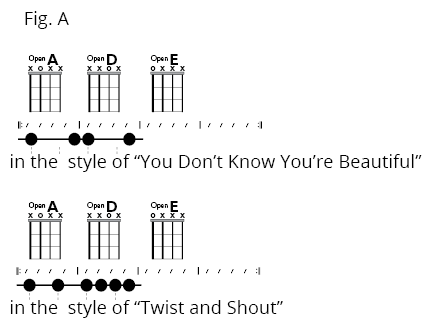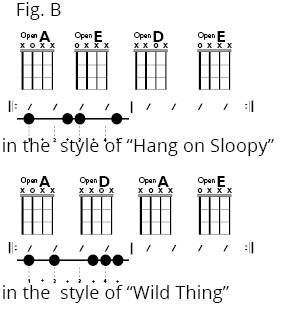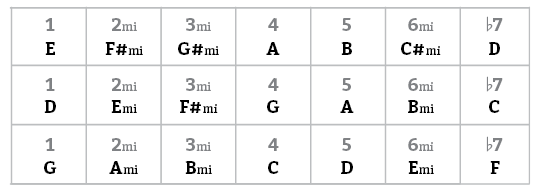LESSON PLAN: 1, 4, 5 (I, IV, V) Progression with A, D, and E
ObjectIVe
Students will be able to use the A, D, and E root notes to play a 1, 4, 5 (I, IV, V) chord progression enabling them to play and recognize this in dozens of songs.
Resources
Song charts and lyrics for “You Don’t Know You’re Beautiful” by One Direction, “Twist and Shout” by The Beatles, “Hang On Sloopy” by The McCoys, and “Wild Thing” by The Troggs.
Procedures
- Practice Playing the A, D, and E
 root notes using open strings. Practice switching between these notes to prepare for using them in songs, keeping in mind that when you start a new note the previous one has to be muted. These bass notes can also be played on guitar if your classroom doesn’t have a bass. Even if you do have a bass, doubling the bass
root notes using open strings. Practice switching between these notes to prepare for using them in songs, keeping in mind that when you start a new note the previous one has to be muted. These bass notes can also be played on guitar if your classroom doesn’t have a bass. Even if you do have a bass, doubling the bass line on guitar always sounds cool and tightens up the groove!
line on guitar always sounds cool and tightens up the groove!
- Play the 1st A, D, and E progression to the songs “You Don’t Know You’re Beautiful” and “Twist and Shout”. Students who are new to doing this may want to play each note as whole notes, while more experienced students can try using the bass rhythms. Since the chord progressions are the same, what makes the songs different is the melody and use of rhythm.
- Play the 2nd A, D, and E progression
 to the songs “Hang On Sloopy” and “Wild Thing”. This time the progression is a little bit different adding an extra D. Here again, the notes are the same making the only difference being the melody and rhythm.
to the songs “Hang On Sloopy” and “Wild Thing”. This time the progression is a little bit different adding an extra D. Here again, the notes are the same making the only difference being the melody and rhythm.
Extension
- The bass notes are represented using open strings which can help us understand the instrument quickly. After this feels easy for students, try playing the same three bass notes beginning with the A located
 at the 5th fret on the lowest string to expand understanding how the instrument works (Figure C).
at the 5th fret on the lowest string to expand understanding how the instrument works (Figure C).
- Discuss bass notes as numbers related to the key you are in. This chord progression is typically called a “1 4 5” progression by musicians because A is the 1st chord in the key, D is the 4th, and E is the 5th. Ask students to use the musical alphabet and name these three notes in different keys. “What bass notes would you use in a ‘1 4 5’ progression in the key of D? How about in the key of G?”

National Core Arts Standards (Music)
Anchor Standard 4: Select, analyze, and interpret artistic work for presentation.Example: General Music MU:Pr4.2.4 b. When analyzing selected music, read and perform using iconic and/or standard notation. Example: General Music MU:Pr4.2.5 a. Demonstrate understanding of the structure and the elements of music (such as rhythm, pitch, form, and harmony) in music selected for performance. Common Core Correlations: CCSS.ELA-Literacy.CCRA.SL.2 Integrate and evaluate information presented in diverse media and formats, including visually, quantitatively, and orally. CCSS.Math.Content.K.CC.B.4 Understand the relationship between numbers and quantities; connect counting to cardinality.

